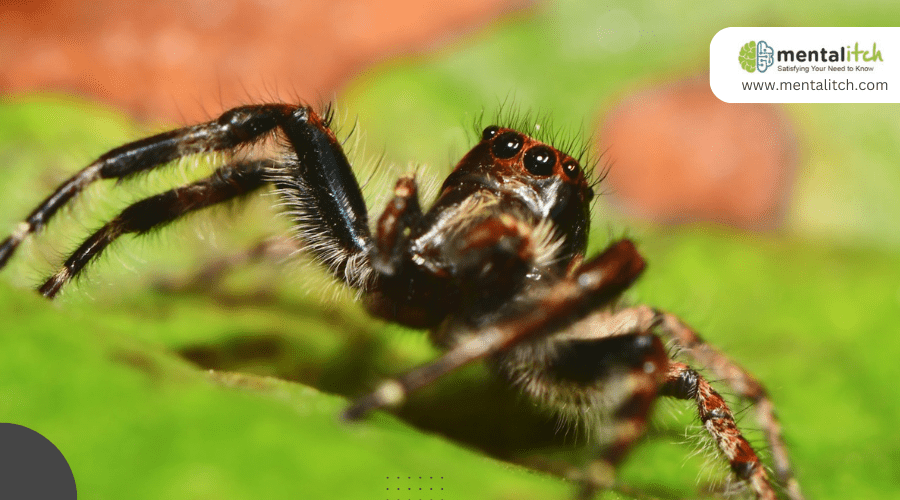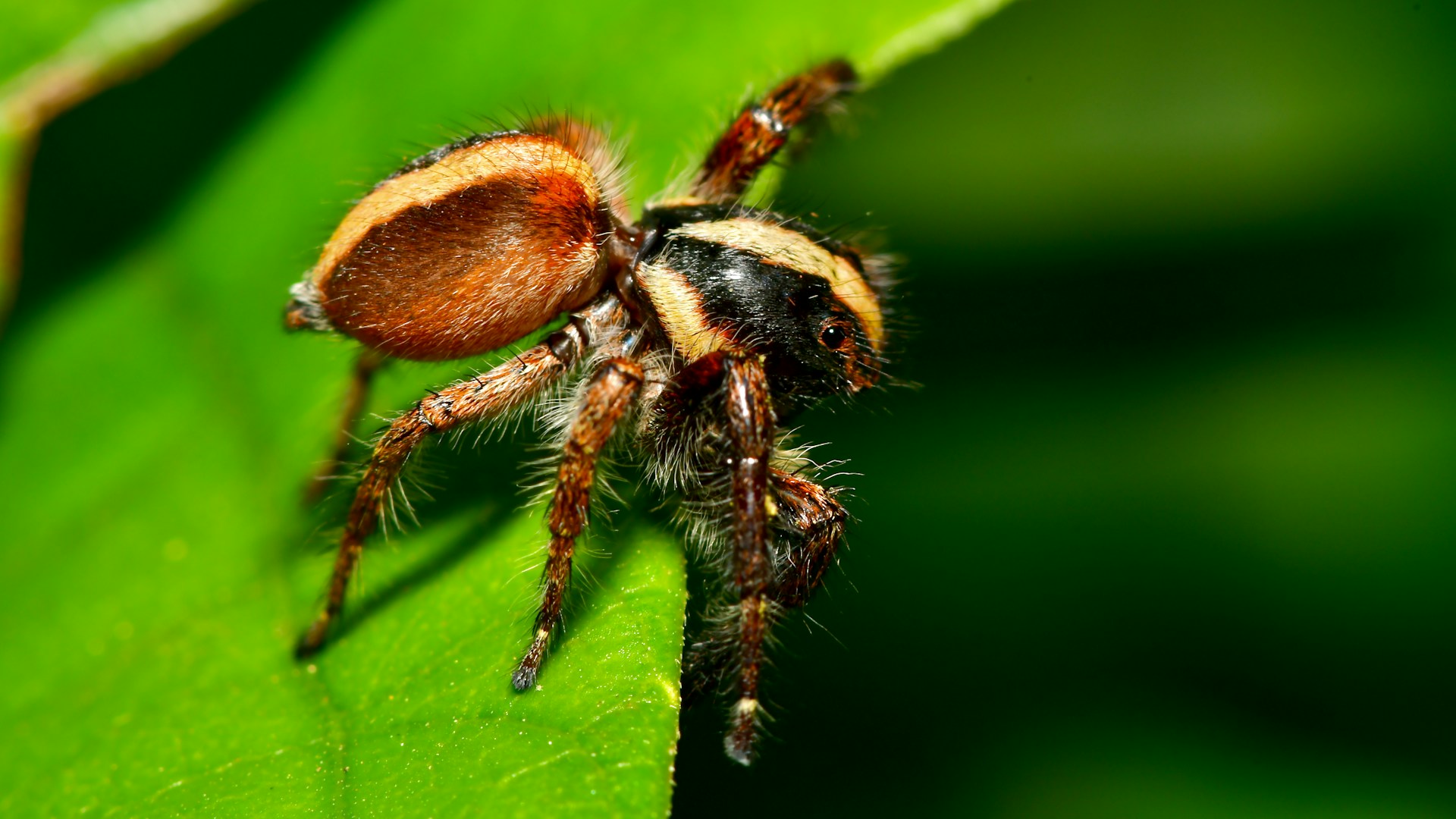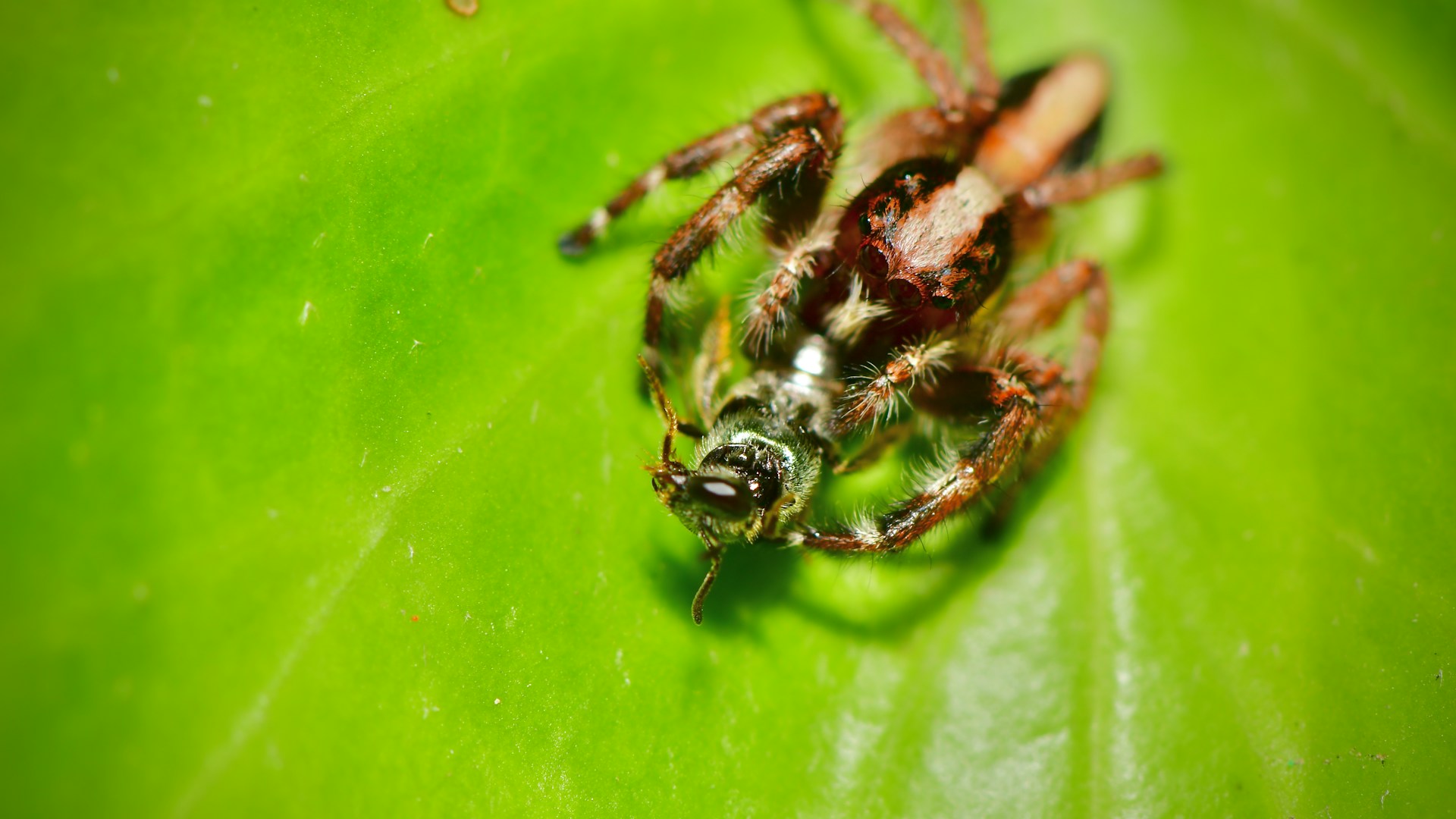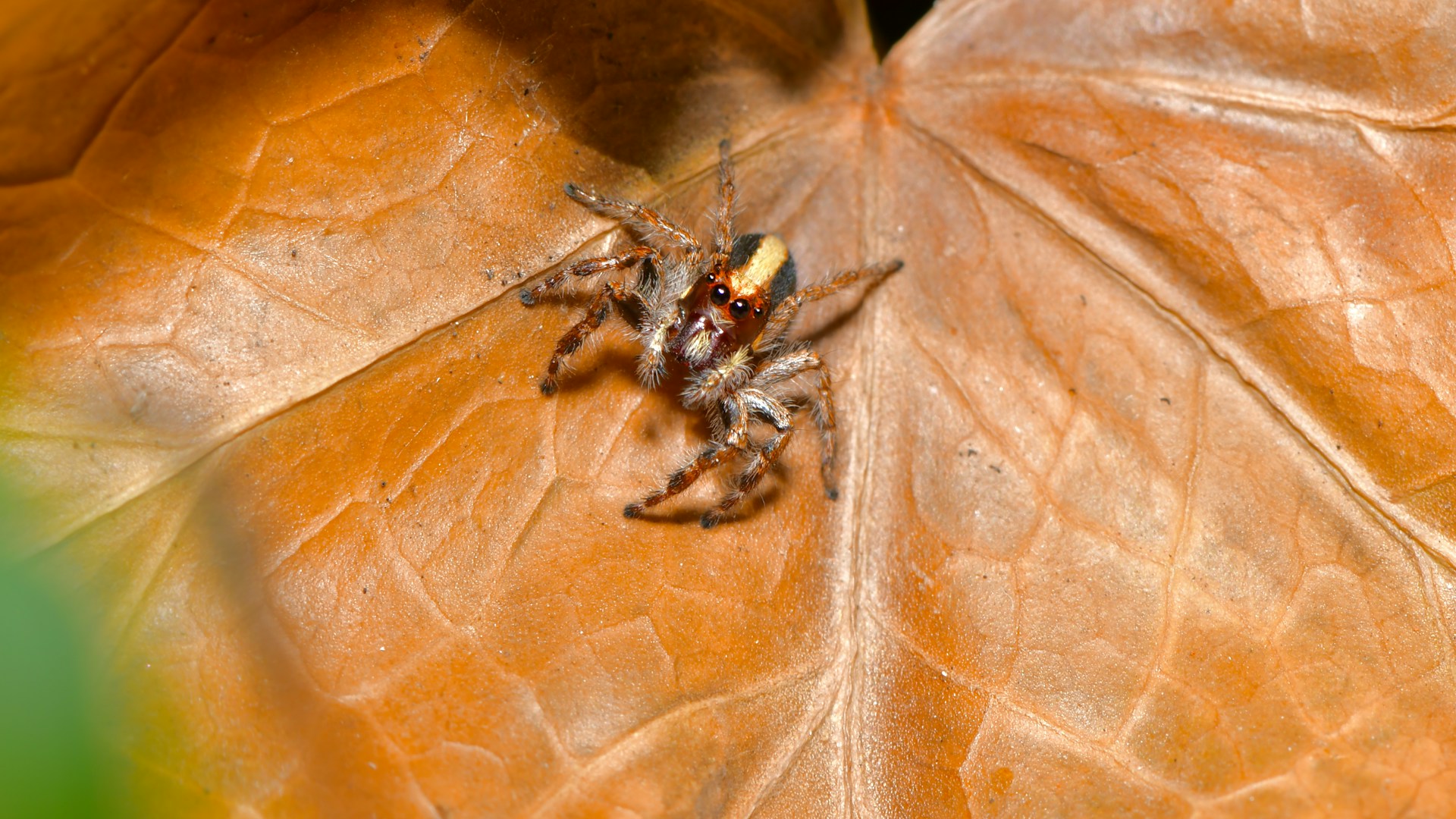Like a lone vegetarian at a barbecue, Bagheera kiplingi stands out in the carnivorous world of spiders with its primarily herbivorous diet. You may find it intriguing that this jumping spider opts for nutritious nodules from acacia trees, a choice that not only distinguishes its diet from its peers but also showcases a fascinating evolutionary adaptation. The spider’s ability to process high-fiber plant material, unusual in the arachnid world, raises questions about its digestive system and nutritional strategies.
As you explore further, you’ll uncover how this unique diet influences everything from Bagheera kiplingi’s habitat choices to its reproductive strategies, offering a glimpse into the complex interplay between diet and survival in the animal kingdom.
The Vegetarian Spider
Among the world’s spiders, Bagheera kiplingi stands out as the sole species adopting a primarily vegetarian lifestyle. You’d find this exceptional vegetarian spider thriving by feasting mainly on Beltian bodies, the protein- and fat-rich parts found on acacia plants. This unique dietary preference sets Bagheera kiplingi apart from its carnivorous counterparts who mainly hunt for their meals.
Beltian bodies aren’t just any plant part; they’re specifically evolved to provide nourishment. For Bagheera kiplingi, these tiny, nutritious gems are the cornerstone of their diet, making them the first and only known spider to lean heavily towards herbivory. It’s a remarkable adaptation, showing just how diverse life strategies can be, even among species traditionally viewed as predators.
This vegetarian spider’s lifestyle isn’t just a curiosity; it’s a sign of the complexity of nature. The existence of Bagheera kiplingi challenges our understanding of spiders, showcasing an unprecedented level of dietary adaptation. Its reliance on Beltian bodies for sustenance is a vivid example of how organisms can evolve unique ways of surviving, even in the competitive world of spiders.
Diet Composition
Moving beyond its notable dietary choice, let’s examine what exactly Bagheera kiplingi eats to maintain its mainly vegetarian lifestyle. This unique spider thrives on a plant-based diet, a rare habit in the mainly carnivorous spider world. At the heart of its diet are Beltian bodies, which are protein- and fat-rich nodules found on acacia plants. These nodules provide over 90% of the spider’s nutritional intake, emphasizing its heavy reliance on plant-based foods.
You might wonder how a spider manages on such a diet. Chemical analysis of Bagheera kiplingi’s tissues has shown isotopic signatures that are typical of herbivorous animals, confirming its herbivorous diet. This spider consumes not only Beltian bodies but also nectar and, on rare occasions, ant larvae. However, the bulk of its diet, about 80%, is made up of fiber-rich Beltian bodies, challenging our traditional views on spider feeding behaviors.
Researchers are delving into how Bagheera kiplingi efficiently digests plant material, considering the evolutionary and environmental factors that might have led to this spider’s herbivorous diet. This exploration into its diet composition sheds light on the remarkable adaptability of Bagheera kiplingi.
Habitat and Feeding Grounds
Residing primarily in Acacia trees, particularly those of the Vachellia species, Bagheera kiplingi has adapted its habitat to guarantee a steady supply of its main food source, Beltian bodies. You’ll find these spiders expertly maneuvering the complex branches of Acacia trees, showcasing an incredible adaptation to their environment. They’ve turned these trees into both their hunting grounds and safe havens, cleverly avoiding predators and securing their unique vegetarian meal.
| Feature | Description |
|---|---|
| Habitat | Acacia trees, specifically Vachellia species. |
| Primary Food Source | Beltian bodies, a type of nutritious nodule produced by Acacia trees. |
| Predation Strategy | Stealth and agility to avoid ants and steal food without being noticed. |
| Alternative Food | Ant larvae and, in scarce conditions, resorting to cannibalism. |
| Symbiotic Relationship | Exploits ant-acacia mutualism without contributing to the ecosystem’s defense. |
In their quest for sustenance, Bagheera kiplingi showcases an extraordinary level of cunning. They actively dodge ants guarding their food, using their agility to slip away unnoticed. Their lifestyle is a demonstration to the spider’s ability to exploit their environment, making them unique in the spider kingdom.
Nutritional Adaptations
Bagheera kiplingi’s unique herbivorous diet, consisting mainly of Beltian bodies, showcases its remarkable nutritional adaptations. Unlike other spider species that rely on a carnivorous diet, Bagheera kiplingi thrives on a menu that’s over 90% plant-based. This dietary choice, while unusual, highlights the spider’s ability to adapt to its environment in innovative ways.
Here are some key points about its nutritional adaptations:
- The spider’s tissues carry isotopic signatures typical of herbivorous animals, which is a direct reflection of its plant-based diet.
- Bagheera kiplingi supplements its diet with nectar and the occasional ant larvae, demonstrating its flexibility and adaptability in sourcing nutrients.
- Its primary food source, the Beltian bodies, are high in fiber yet low in essential nutrients, challenging the spider to employ unique digestive processes.
Researchers are delving into how this spider manages to process and digest plant material effectively. This exploration into Bagheera kiplingi’s diet and digestive mechanisms may very well alter our understanding of nutritional adaptations across different species, offering insights into the vast dietary spectrum in the animal kingdom.
Evolutionary Path
Delving into the evolutionary path of Bagheera kiplingi, it’s clear that this spider’s shift to a herbivorous diet marks a significant divergence from the carnivorous tendencies of its kin. You’re seeing a creature that, driven by environmental factors or perhaps a scarcity of traditional prey, decided that munching on leaves was a better survival strategy than hunting. This isn’t just a quirk; it’s a fundamental change in how Bagheera kiplingi interacts with its world.
Imagine, over 90% of its diet is plant material. That’s not just unusual; it’s practically unheard of among spiders. You’ve got a spider here that’s flipped the script, relying on the nutrients found in leaves rather than the proteins and fats from insects. The isotopic signs in its tissues don’t lie; they’re a concrete proof to this evolutionary divergence. It’s as if Bagheera kiplingi looked at the menu of life and chose the salad bar over the steakhouse.
This evolutionary adaptation highlights how environmental pressures and resource availability can lead to drastic changes in feeding behaviors. Bagheera kiplingi’s herbivorous diet isn’t just a dietary preference; it’s an evolutionary statement.
Impact on Ecosystem
Understanding the unique dietary habits of Bagheera kiplingi leads us to explore its notable impact on the ecosystem. Unlike its carnivorous kin, this spider opts for a menu primarily composed of plant materials, specifically the protein-rich Beltian bodies offered by acacia plants. This unusual choice doesn’t just set it apart in the spider world; it markedly alters the dynamics within its habitat.
Here’s how Bagheera kiplingi impacts its ecosystem:
- Resource Distribution: By consuming Beltian bodies, these spiders change how resources are allocated among the inhabitants of their ecosystem, particularly affecting the availability of these nutrients for ants that rely on the same food source.
- Ant Protection Levels: The presence of Bagheera kiplingi on acacia plants can lead to a decrease in ant protection levels. Ants are drawn to acacias for the Beltian bodies and ant larvae, but with spiders consuming a significant share, ants may be less incentivized to defend these plants.
- Mutualism Dynamics: The spider’s feeding behavior can disrupt the mutualistic relationship between ants and acacia plants. With fewer ants to protect them, acacias might be more susceptible to other threats.
Comparison With Carnivorous Spiders
In contrast to their carnivorous counterparts, Bagheera kiplingi spiders have adapted to a primarily herbivorous diet, setting them apart in the spider community. Unlike most spiders that rely on hunting insects for sustenance, these unique Jumping Spiders feast on Beltian bodies and nectar from acacia trees. These protein-rich nodules offer a stark contrast to the typical diet of their carnivorous kin, showcasing Bagheera kiplingi’s specialized adaptation to its ecological niche.
This shift in dietary preference challenges what you might typically expect from spiders. While the vast majority of their relatives engage in the predatory behavior characteristic of carnivores, Bagheera kiplingi breaks the mold by consuming plant materials. This not only sets them apart in relation to diet but also highlights the diversity and adaptability within the spider species. By relying on Beltian bodies for nutrition, these spiders demonstrate an exceptional case of dietary adaptation that defies the common perception of spiders as purely carnivorous creatures. This unique feeding habit underscores the complexity of ecological roles that spiders, including Bagheera kiplingi, can occupy.
Reproductive Strategies
Bagheera kiplingi’s reproductive strategies are as unique as their diet, involving specific courtship behaviors and protective measures for their offspring. Just like their intriguing feeding habits set them apart from most other spiders, their mating rituals and care for the next generation highlight the exceptional nature of these arachnids. Understanding these behaviors is vital in appreciating how they’ve adapted to guarantee the survival and continuation of their species.
Here are some key aspects of their reproductive strategies:
- Courtship Displays: Males engage in elaborate courtship behaviors and displays to attract females. These rituals are critical for successful mating, showcasing the importance of communication and compatibility in their reproductive process.
- Protective Egg Sacs: Females lay their eggs in silk sacs, providing a secure environment for their young. Within these sacs, the offspring go through multiple molts before they are mature enough to venture out, ensuring they are well-protected during their most vulnerable stages.
- Strategic Nest Building: Males may construct nests near immature females, positioning themselves for future mating opportunities. This foresight in securing mating prospects underscores the strategic nature of their reproductive approach.
Threats and Conservation
While we’ve explored the unique aspects of Bagheera kiplingi’s reproduction, it’s important to also address the challenges they face, including habitat loss and climate change. This remarkable spider, which relies heavily on a diet of Beltian bodies and nectar from acacia trees, finds itself in a precarious situation. Habitat loss, spurred by deforestation and rampant land development, directly threatens their living space and food sources. As trees vanish, so do the essential resources Bagheera kiplingi depends on for survival.
Moreover, climate change exacerbates these threats, disrupting the delicate balance of their unique habitat and the ant mutualism critical for their diet. The shifts in weather patterns and temperatures can affect the availability of Beltian bodies, making it harder for these spiders to find nourishment.
Conservation efforts are hence imperative. Protecting acacia trees and ensuring the continuation of ant mutualism are steps towards safeguarding the spider’s ecosystem. These measures not only help maintain the availability of their peculiar diet but also contribute to the broader objective of preserving biodiversity. Protecting Bagheera kiplingi’s habitat is essential, enabling these unique creatures to thrive despite the pressing challenges they face.
Research and Discoveries
Recent studies have revealed that Bagheera kiplingi’s shift to a herbivorous diet is a remarkable adaptation, challenging our traditional views on spider feeding habits. You might find it fascinating that this unique spider dines exclusively on Beltian bodies from acacia plants, making it stand out in the spider world. This shift not only showcases an unusual dietary preference but also points to a significant ecological relationship.
Here’s what recent discoveries have shown us about these herbivorous spiders:
- High-definition video recordings have provided undeniable evidence of Bagheera kiplingi’s herbivorous tendencies, capturing their unique feeding behavior in action.
- Laboratory analyses reveal striking similarities between the diet of Bagheera kiplingi and acacia-ants, indicating a specialized adaptation to herbivory that few other spiders share.
- The conversion to herbivory is closely linked to the coevolution between ants and acacia plants, suggesting that Bagheera kiplingi exploits this relationship to access a plant-based diet.
These findings not only deepen our understanding of Bagheera kiplingi but also challenge the notion that all spiders are carnivorous. It’s a reminder of nature’s endless capacity for adaptation and the intricate connections within ecosystems.
Conclusion
To wrap up, you’ve witnessed how Bagheera kiplingi stands out among its carnivorous kin by thriving on a mostly vegetarian diet. This unique adaptation to munch on Beltian bodies allows it year-round food access, setting it apart in the spider world. Its evolutionary journey showcases nature’s ability to innovate for survival. While it faces challenges similar to other spiders, ongoing research may expose more about its unique lifestyle, offering insights into the complexity of nature’s web of life.



